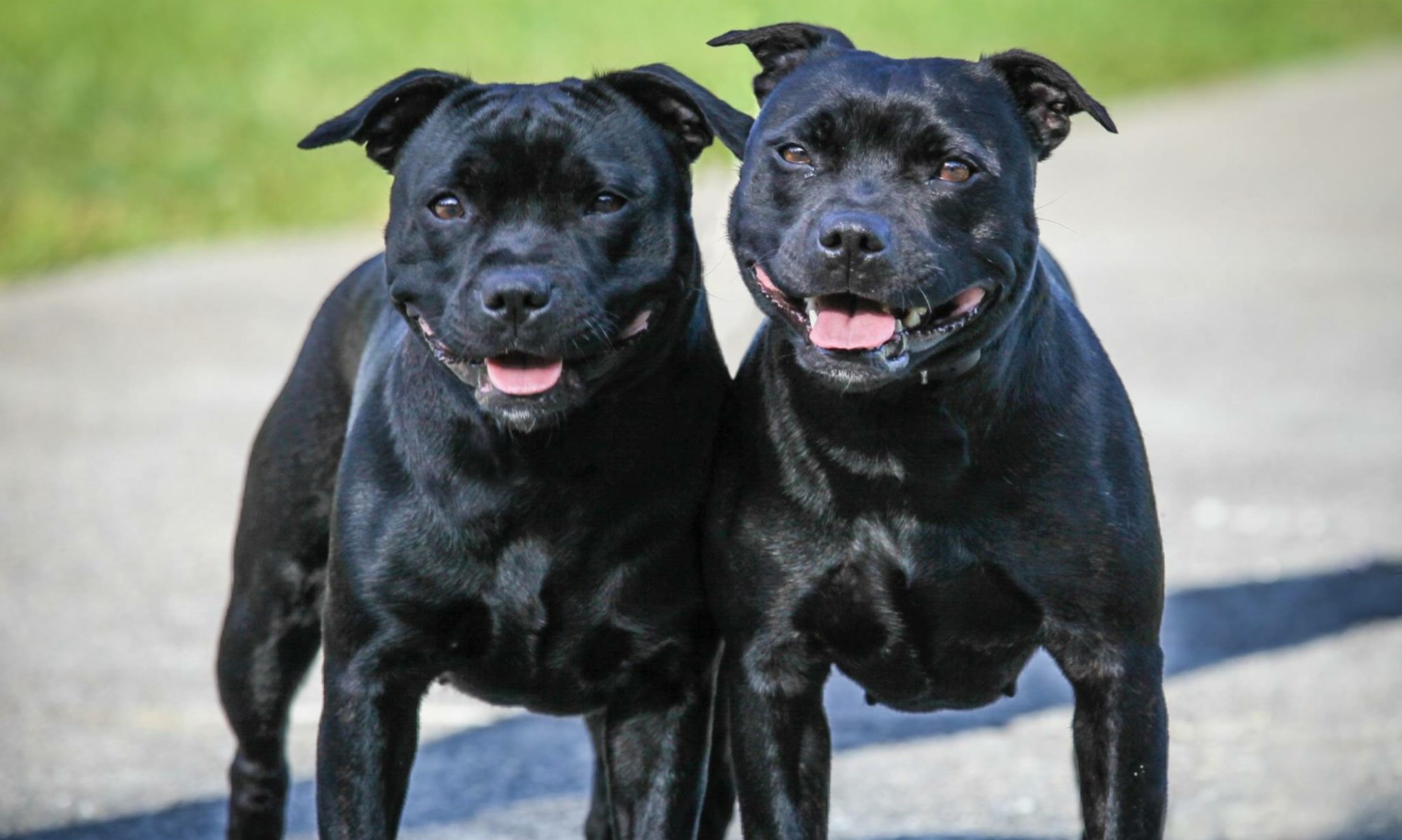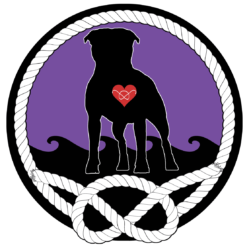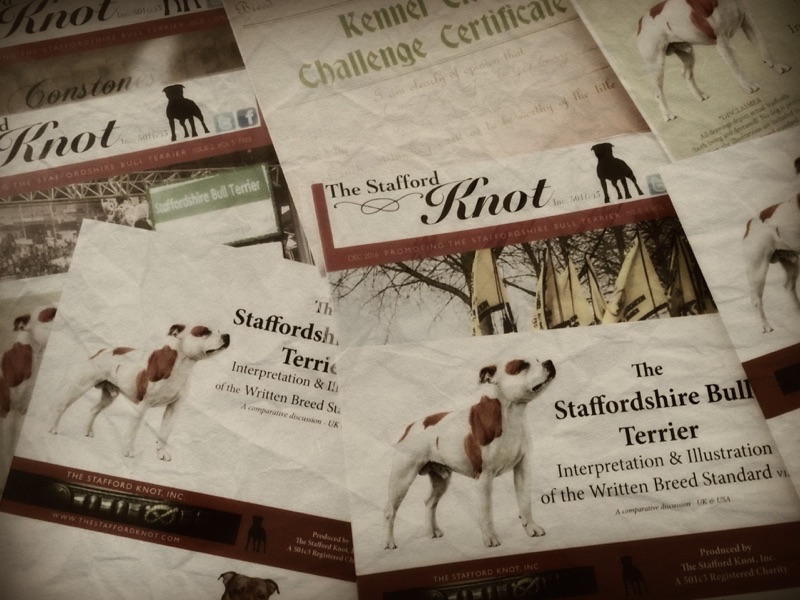There is a disturbing trend happening in the dog world. It’s not the first time this happened but it seems to be the first time it has so directly involved this breed. Trends are never a healthy thing in purebred dogs. This has taken its toll on me personally.
Some unethical and selfish people are breeding Staffords for specific purposes other than the intended purposes of this wonderful versatile breed – such as below standard smaller size, super extreme high drive & excessive tenacity, specific color and pattern or other non standard traits which will bring in more puppy sales for them. This is my blog so I am perfectly comfortable calling things as I see them. I especially feel okay since I also see the other side of this in my work with Stafford rescue.
We now have people breeding something called the ‘Miniature Staffordshire Bull Terrier’ to which my response is get yourself another breed. Dwarfism isn’t a healthy trait and joint, structure, health issues will occur when you begin selecting your breeding partners for smaller and smaller sizes. You don’t believe me? Ever go to a ‘Bully Fest”? Google American Bully and have yourself a look. Like what you see? Do you want to see Staffords heading down this road too? What do you think the life span is of these animals? Think there is any pain involved? Think they can reproduce naturally? What about spinal injury occurrences? I am perfectly fine naming and shaming if you call me and ask me for names of ‘breeders’ doing this. I personally know people who own some extra tiny below standard Staffords. They will tell you all about the heartbreak of injuries and health concerns. You cant make this stuff up.
So called ‘sport breeders’ are producing Staffords with such extreme drive and energy that nobody can live with these dogs on a daily basis. There is no off switch. They want dogs to compete and win at sports. Thats it. Nothing to do with a breed standard or health testing – just fast, small, drivey. Have you ever wondered what happens to all the puppies from these ‘sport bred’ litters who dont make the cut? The ones who either don’t excel at the intended sport or those sold to families instead of being put to work daily? Let me tell you. They end up being re-homed either to rescue (Hi thats me) or sold from home to home to home on Craigslist, etc. or being dumped at the pound to die. Now lets discuss the ones they do keep to do their chosen sport – they are worked from week one. They teach them to tug, run, grab, go go go go go – always on. They are worked before growth plates have closed – they are worked hard and often beyond injury and fatigue. These are not pets. These are means to a goal for owners. These ‘breeders’ and owners are only after one thing. Personal attention – “look at me – my dog is number one – look what my dog can do – doesn’t that make me terrific?!” Then after they begin to not win guess what happens then. They are either ‘retired’ meaning sold or given away, dumped with rescue (hi again) left alone in crates and kennel runs or used for breeding purposes only. This issue isn’t isolated to sport folks either – lots of conformation people are exactly the same but thats another blog post for another day…..
Then we have those who are not involved in the mainstream breed ‘family’ at all and they buy Staffords specifically to breed because they supplement their income with these dogs. Some are honest about it advertising on Next Day Pets and the like. Others lie to themselves and say they are breeders of champions therefore its all legit. These ‘breeders’, if not also breeding for the above traits, only breed for the popular colors or patterns in order to make their puppies more desired by the masses of the ignorant public. You may see blue to blue (no health testing at all just chosen for dilute), you may see black and tan or tri color bred purposely (a disqualification in the breed), you may see a combination of those as blue and tan and in fact you also may see merle which doesn’t even exist in this breed therefore you know for a fact they are not purebred.
Some don’t breed for these traits at all but they call themselves ‘show breeders’ but when you look at their dogs you may wonder what breed it is. I do not consider these people breeders – to me that just making puppies. Like in a factory or on a farm. Their dogs represent cash not family. Their dogs may be studded out at very young ages with no testing done, they may always have a litter available, they may take non refundable deposits, they may have paypal buttons on their websites, they may also say ‘health tested’ but somehow cant come up with proof. They may brag about the show or sport wins before they ask you about what kind of home will this puppy grow up in or before they get to know you because in reality – they don’t care. They wont remain in touch with you beyond the sale unless your contract states you have to breed your Stafford and give them puppies back. See a theme here?
And another thing – bear with me please – I came into this breed with a pet quality Stafford I purchased as a pet but allowed the breeder to make me show her. Thankfully I had the sense not to breed from her and she was soon spayed. My second Stafford was slightly better quality. I had learned a little more about the breed standard at this point. I had great success with this dog even though I knew he had many faults. I often wondered what the judges were thinking when they praised his more extreme qualities rather than his overall balance and fitness. I wrote about this in a very early blog here. Then I continued with a 3rd Stafford who in herself wasn’t a fantastic bitch in some ways but in other ways was quality. I began to understand the importance of fully health testing my dogs and publishing results, good or bad. I began to test my Staffords in performance and conformation. I bred my bitch understanding I would be lucky to get 1 show quality pup in a full litter – unlike so many others around me who sent full litters out with handlers to champion them all and in turn breed mediocre or faulty Staffords. I continued along on a slow path choosing what I wanted and where I wanted to go and understood more and more as I went along where my mistakes were made and where my good decisions fell closer to the path I sought. I made good connections within the dog community and I contributed back as I took from it. We returned from our first time at the PSBTC shows glowing with excitement from all we had learned. Lightbulbs had turned on. Wow was there so much to learn about this breed! We had been fooled into thinking what we saw and what we read were unrelated! Once we saw good examples of the breed we immediately understood so many things. We were met with a fellow exhibitor saying (as he rolled his eyes) “ut oh Lynnie and Jim have gone to the dark side”. This man is an AKC judge now.
All along, my frustrations grew – not only with the topics in this very long blog (time for you to take some B-12 if you want to keep up). I grew frustrated with watching handlers showing mediocre Staffords and winning anyway, therefore justifying the wins with – this is how I make a paycheck, or don’t have sour grapes…now sometimes a handler was showing fantastic examples in my mind and even they couldn’t be found in the ring – now that was even more frustrating to me. I was secretly pulling for those dogs to excel to justify what I was learning. How could a judge not see these dogs as being so close to our standard? Why is it that only other Stafford breeder judges found them?
Now of course I understand that I am not the police of the breed and I have zero control over what these folks do….it’s really none of my business – society will sort itself out eventually – but my concern mainly is to educate my readers so they understand that people who breed for these traits do not have these wonderful dogs in mind – only either selfish goals, ego or money. How does that affect me you may wonder? Why this lengthy blog post? Still reading? Two reasons – first – the cast offs come to rescue and now they become my problem. I clean up the mess these people are creating. (loads of conformation breeders are a part of this problem also, its not isolated to the above described people) It now becomes my expense and burden to find great homes for these dogs. These dogs are not perfect. They come with all kinds of structural, health or behavioral problems that now others must deal with. I’m burned out with exhaustion over this to be quite honest.
Let me vent a minute longer if you are still reading. I receive rescue requests daily. Most people will first tell me they just want to adopt a Stafford in need. However, a little more conversation and I get this – in reality they just do not wish to pay for a well bred health tested puppy b/c either they aren’t ideal themselves and have been turned down repeatedly by good breeders, they are too cheap to pay for a quality purebred Stafford or they are never going to be satisfied with any rescue or re-home I find for them. Seriously. Some people are so picky about wanting the absolute perfect pet. Hey people – why the hell do you think this dog is in need of a new home anyway?! It has issues and we need homes to help them work through them, or a health issue and we need a home willing to care for a special needs dog, or its old or it is dog aggressive or its never been trained to do anything at all! This isn’t Macy’s ffs.
Now I know not everyone wanting a rescue or re-home is like this. I know. Stop rolling your eyes at me. But you really wouldn’t believe the daily messages I get. I have to remain polite and helpful and do my best to match dogs with homes or politely turn them away. I have rehomed many many Staffords into fantastic loving well meaning homes over the years. Honestly I have. I also remain in touch with most of them the same way I do with my puppy buyers.
We are the custodians of the breed. It is our responsibility to make sure the breed, as it is described in our breed standards, are preserved as such for generations beyond our lives to enjoy as they were meant to be. The Stafford was one of the healthiest of the terriers living well beyond the years of most dogs of its size and structure. There was a study on this conducted in the late 90’s by University of Texas. The Stafford temperament was one of a stable and reliable dog. You get a Stafford and you know what to expect. Some tenacity, some prey drive, loads of enthusiasm and willingness to please – but – also an off duty quietness. Important.
Secondly it is extremely disturbing to see some of these ‘sport breeders’ doing anything they can to steal the joy from those before them who come to the start line with in standard, health tested, well planned, trained and healthy Staffords and bring a steroid injected, dehydrated, sport bred, crazy, unstable animal and say – now we beat you and we win and you lose. Nope. Sorry. We all lose. You lose. I lose. The breed loses. You can talk all you want about how your dogs are beating my dogs at a sport – it washes off my back and makes you look like a very sad, lonely person who cares more about the brags than the dogs on your leashes (and shock collars). Just look at your dogs faces. Do they have that sparkle in their eye that my dogs have? No. They look defeated because after they run, after they jump, after they walk in a left hand circle over and over and over again – they are shoved back into a crate in the van while you go off to do your thing. They don’t get that love my dogs get. I can see it in their eyes. And when they do not win – oh boy – that makes me so sad. I see you jerk them by the collar, I hear you curse at them.
And with this – I say – you cannot steal my joy. You are really trying to. You have a times been soooo close to doing so. You cannot affect the joy my dogs feel from me. My dogs are not my life because they have excelled at sports and in the conformation ring – they are my joy because I live with these fantastic wonderful animals every single day – spending my time with them no matter what. They are my companions. They are my family. I am proud of the achievements we have accomplished together. I look at them and get goosebumps. They don’t have to be doing a damned thing. But even without any of these top awards – and trust me if you follow me at all you know there have been numerous firsts and top spots in the breed made by my dogs – (see, there I bragged a bit) these dogs are my love, my life, my reason to smile.
I do not wish to stick around long enough to watch what is happening to this breed by those who are not passionate about them like I am. You may see us sometimes at events if we feel like attending or seeing old friends or having a day of fun, attending the occasional specialty show, breeding a litter now and then . . . . but we are pretty much finished with the non stop weekend dog events. We spent almost 15 years living 24/7 for the Staffordshire Bull Terrier. We have probably done more for this breed than most of the people in the breed in so many ways. (its not a brag if its the truth is it?) We have raised and donated 1000’s and 1000’s of dollars and worked many 1000’s of hours for clubs, rescue, BLS, committees, shows, graphics/photography, online stores, auctions, sponsorship, advertisements – we have created many outlets for education about this breed through the non profit work of The Stafford Knot, sales from Thankdog – All Breeds Equal and this website. I feel pretty good about all we have contributed.
A year from now most people may not even know who we are and thats ok too. We will be here at home with our Staffords and know that we did a great job. We helped do our part to preserve this unbelievable breed. We didn’t cheat. We didn’t boast (much). We didn’t allow our dogs to represent our self worth. We enjoyed our dogs and will continue to do so. Its now time to relax, enjoy life. And with that…….we retire. We go out on top in our eyes.













